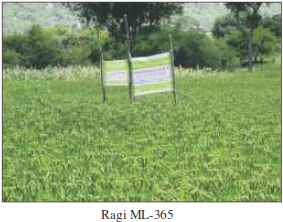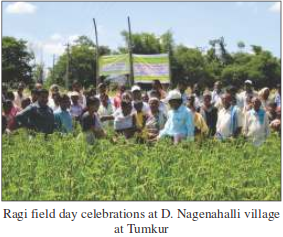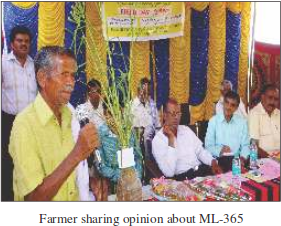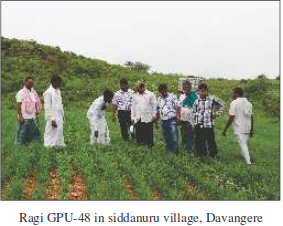Short duration finger millet varieties for delayed monsoon/deficit rainfall districts in south interior Karnataka
Short duration finger millet varieties for delayed monsoon/deficit rainfall districts in south interior Karnataka
Climate vulnerability: Drought
Existing practice
Finger millet is an important staple rainfed crop in south interior Karnataka. A sizable area under finger millet is also cultivated with limited irrigation during kharif. Long duration varieties with higher productivity such as MR-1 and MR-6 are grown with irrigation facility by farmers. Although sowing of finger millet can be taken up from 2nd week of June to end of August, productivity with long duration varieties goes down with delayed planting especially under rainfed situations. Alternative is to opt for short duration varieties of about 100-110 days duration so as to ensure higher productivity and profitability to farmers.
Resilient practice / technology
When the delay in monsoon is about 4 weeks, medium duration varieties like GPU-28 (110 days duration) performed better while in case of further delay, short duration varieties like ML-365 (105 days) and GPU-48 (100 days) performed better. These short duration varieties of finger millet are also tolerant/ resistant to blast disease and can be sown till August under rainfed conditions in medium to deep red soils.
Impact of short duration finger millet varieties
Farmers in D. Nagenhalli, Tumkur, Karnataka adopted short duration finger millet variety ML-365 in 2011 and 2012 when faced with delayed onset of monsoon. ML-365 performed significantly better with an average yield advantage of 33% and a benefit cost ratio of 2.7 compared to other varieties cultivated in the village. Shri Muddha Hanumaiah, a finger millet farmer in the village, obtained an additional income of Rs.5250 from his 0.5 ha. Similarly, 70 other farmers benefitted from the introduction of this short duration variety in the village in the first season. Apart from good grain quality and fitting into contingency situations, this variety has good fodder quality and improves milk productivity in milch animals.
At Siddanuru village in Davangere district, Karnataka in the Central Dry Zone average annual rainfall is about 653 mm. In this drought prone village during 2011 and 2012, 15 farmers took up sowing of short duration variety of finger millet (GPU-48, 100 days) in 7 ha area. The variety performed better with an average yield of 22.5 q/ha with an yield advantage of 38% compared to PR-202 variety (115 days) and a benefit: cost ratio of 2.8.
Scope for upscaling
Short duration varieties of finger millet which are suitable for tackling contingency situations under rainfed conditions should enter into the seed supply chain. In D. Nagenahalli NICRA village, ML-365 variety is produced by farmers and the village has become self-reliant in seed availability in about three years time. Scope exists for wider adoption of such short duration varieties which are suitable for late planting in case of delay in monsoon or due to deficit rainfall conditions in July. Finger millet is grown as a rainfed crop during kharif season in all the 11 districts in South Interior Karnataka and scope exists for imparting resilience to finger millet cultivation by creating seed banks and ensuring seed supply to meet contingency situations arising out of an aberrant monsoon rainfall.




Source: Smart Practices and Technologies for Climate Resilient Agriculture
Last Modified : 3/1/2020
This topic provides information about Community pa...
This topic provides information about Crop diversi...
This topic provides information about Captive rear...
This topic provides information about Check dams f...
